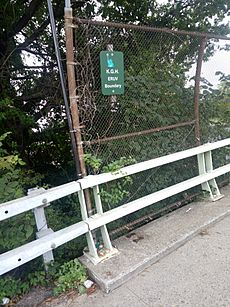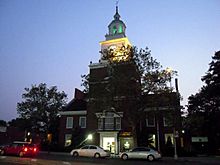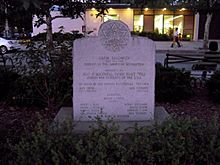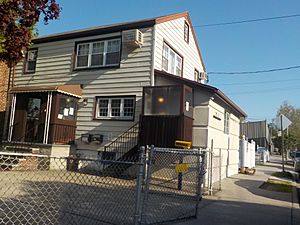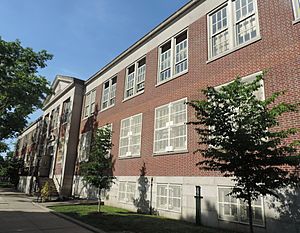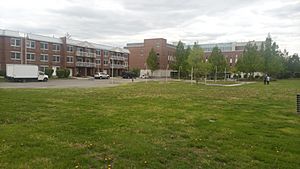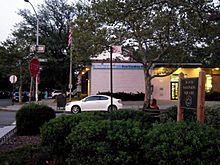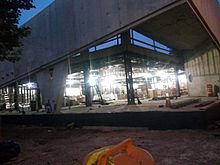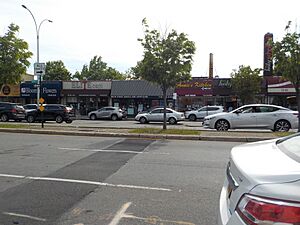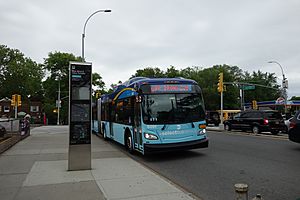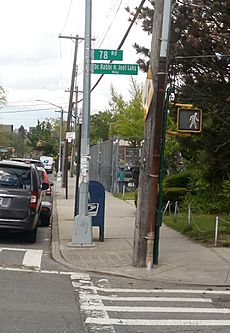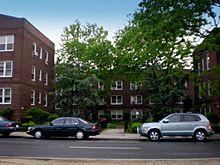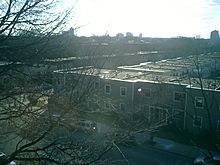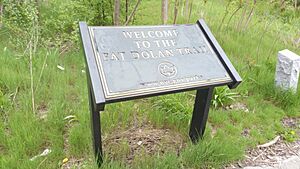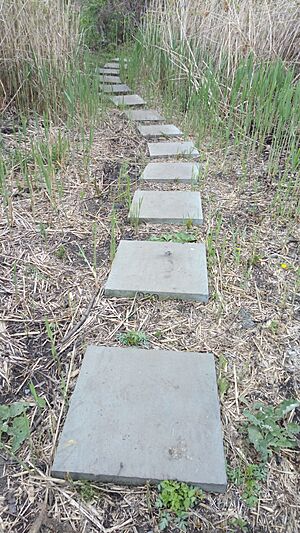Kew Gardens Hills, Queens facts for kids
Quick facts for kids
Kew Gardens Hills
|
|
|---|---|
|
Neighborhood in Queens
|
|
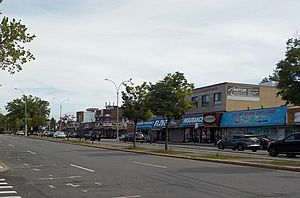
Main Street, one of the shopping centers of Kew Gardens Hills, May 2020
|
|
| Country | |
| State | |
| City | New York City |
| County/Borough | Queens |
| Community District | Queens 8 |
| Named for | Kew Gardens, Queens; in turn named after Royal Botanic Gardens, Kew |
| Area | |
| • Total | 3 km2 (1.0 sq mi) |
| Population | |
| • Total | 37,479 |
| Race | |
| • White | 53.9% |
| • Asian | 20.0% |
| • Hispanic | 14.8% |
| • Black | 7.6% |
| • Other | 3.7% |
| Economics | |
| • Median income | $95,847 |
| Time zone | UTC−5 (EST) |
| • Summer (DST) | UTC−4 (EDT) |
| ZIP Code |
11367
|
| Area codes | 718, 347, 929, and 917 |
Kew Gardens Hills is a friendly neighborhood in the middle of Queens, one of New York City's five boroughs. It's known for its tree-lined streets and a mix of homes and apartment buildings.
The neighborhood is bordered by Flushing Meadows–Corona Park to the west and the Long Island Expressway to the north. To the south, you'll find Union Turnpike, and Parsons Boulevard is to the east.
Kew Gardens Hills is easy to get to because it's near several major highways. These include the Long Island Expressway, Grand Central Parkway, Van Wyck Expressway, and the Jackie Robinson Parkway. Many bus routes also serve the area. Nearby neighborhoods include Forest Hills, Hillcrest, Briarwood, and Queensboro Hill.
This area is part of Queens Community District 8. Its main ZIP Code is 11367. The New York City Police Department's 107th Precinct keeps the neighborhood safe.
Contents
- Kew Gardens Hills: A Queens Neighborhood
- Images for kids
Kew Gardens Hills: A Queens Neighborhood
Where is Kew Gardens Hills?
Kew Gardens Hills is located in the southwestern part of what was historically known as the Town of Flushing.
Since New York City neighborhoods don't have official boundaries, people use different ways to describe where Kew Gardens Hills is:
- General Borders: The western edge is usually considered to be Flushing Meadows–Corona Park. The Van Wyck Expressway separates the neighborhood from most of the park. However, a playground area of the park is actually inside Kew Gardens Hills.
- Postal Boundaries: Since 2003, the post office for ZIP Code 11367 is called the "Kew Gardens Hills Post Office." For mail, the area stretches from Union Turnpike in the south to the Horace Harding Expressway in the north, and east to Parsons Boulevard. Even with the new name, the post office still uses "Flushing" as the city for addresses.
- Other Designations: Some parts east of Parsons Boulevard, west of 164th Street, and south of Union Turnpike are also sometimes included. This depends on who you ask, like the NYC Department of Education or local residents. These areas might have different ZIP Codes, but they are still considered part of Kew Gardens Hills.
Neighboring communities include Forest Hills to the west, Hillcrest and Pomonok to the east. To the south is Briarwood, and to the north is Queensboro Hill.
A Look Back: History of Kew Gardens Hills
From Farmland to Neighborhood
Long ago, the northwestern part of the neighborhood was a large farm called Spring Hill Farm. This farm was once owned by important people in colonial times. Later, it became the office for Cedar Grove Cemetery.
In the 1800s, the area was known as Head of the Fly. This name came from its location at the start of the Flushing Creek. "Fly" is a Dutch word for swamp. An old road called Vleigh Road still exists today as Vleigh Place.
There was even a horse race track here, built by Timothy Jackson. It was called Whitepot Race & Track. Today, this area is a subway train yard, but it's still named Jamaica Yard because it serves subway lines that start or end in Jamaica.
In 1898, the Town of Flushing, which included this area, became part of the Borough of Queens. Later, the neighborhood was named after Kew Gardens. This name, in turn, came from the famous Royal Botanic Gardens, Kew in London, England.
The first modern homes were built in 1917. But in the early 1900s, the area was mostly farmland and known as Queens Valley. By the 1920s, many farms were sold and became golf courses.
Growing Up in Kew Gardens Hills
Kew Gardens Hills really started to grow when a subway line opened in nearby Kew Gardens, Queens in 1936. Also, Flushing Meadows–Corona Park, which is close by, hosted the 1939 New York World's Fair. Many early residents moved here from Brooklyn and Manhattan. The area was hilly, and Kew Gardens was seen as a fancy neighborhood, so developers changed the name from Queens Valley to Kew Gardens Hills.
Main Street was paved and bus routes began in 1941. The Jewish Center of Kew Gardens Hills was also started in 1941. The Queens County Savings Bank opened in 1949, and a local school, P.S. 164, opened its doors that same year.
The Main Street Cinemas, a movie theater, opened in 1940. It was considered one of the city's best. It later became a six-screen theater but closed in September 2022.
On September 16, 2010, a strong windstorm called an EF1 tornado hit Flushing Meadows–Corona Park. It caused a lot of damage to cars and homes in Kew Gardens Hills. John Bowne High School was the only public school building in New York City to be damaged by the storm.
Who Lives in Kew Gardens Hills?
In 2010, the population of Kew Gardens Hills was about 37,479 people. The neighborhood is very diverse. About 53.9% of residents are White, 20.0% are Asian, 14.8% are Hispanic, and 7.6% are Black.
Most people living in Kew Gardens Hills are middle-aged adults and young people. About 20% are under 18, and 28% are between 25 and 44 years old. The average life expectancy here is 83.9 years, which is higher than the average for New York City.
The neighborhood is considered a middle-class area. Many residents have an Orthodox Jewish background. There are also groups of Israelis, Bukharan Jews, Latinos, Koreans, Chinese, Indians, Afghans, and African Americans. Kew Gardens Hills has the largest group of Afghanis in the New York City area.
There are many places of worship in Kew Gardens Hills, especially Jewish synagogues. The Jewish Center of Kew Gardens Hills was started in 1941. The first Orthodox Jewish synagogue was formed in 1950. Other places of worship include the Roman Catholic Church Queen of Peace and the Lutheran Church of the Ascension. There are also Muslim and Sikh populations, especially on the northern side of the neighborhood.
Learning in Kew Gardens Hills
Kew Gardens Hills has many residents who have gone to college. About half of the adults here have a college degree or higher. Students in Kew Gardens Hills do well in school. For example, the percentage of elementary school students doing well in math increased from 51% in 2000 to 71% in 2011.
Public Schools
The New York City Department of Education runs the public schools in Kew Gardens Hills. Here are some of the elementary and middle schools:
- PS 154
- PS 219 Paul Klapper
- PS 201 The Discovery School for Inquiry and Research
- PS 255 (grades PK-5, 8)
- PS 164 Queens Valley (grades PK-8)
- PS 165 Edith K. Bergtraum (grades PK-8)
- The Queens College School for Math, Science and Technology (grades PK-8)
- PS/MS 200 – The Pomonok School & STAR Academy (grades PK-8)
Middle schools include:
- I.S. 250 The Robert F. Kennedy Community Middle School (grades 6-8)
- The Queens School of Inquiry (grades 6-12)
High schools in the area are:
- John Bowne High School
- Robert F. Kennedy Community High School
- Townsend Harris High School (for academically talented students)
- North Queens Community High School (helps students get their high school diploma)
Colleges and Universities
Kew Gardens Hills is home to two college campuses:
- Queens College is a liberal arts college that is part of the City University of New York (CUNY) system. It's also a cultural hub with places like the Colden Center for the Performing Arts. Famous people like Jerry Seinfeld and Paul Simon went to Queens College.
- Lander College, a men's college that is part of Touro College, has a large campus on 150th Street.
Private Schools
Several private religious schools are located in Kew Gardens Hills:
- Yeshiva Chofetz Chaim
- Lander College for Men (part of Touro College)
- Yeshivas Ohr HaChaim (part of Touro College)
- St. Nicholas of Tolentine
- Shevach High School
- Mesivta Yesodei Yeshurun
- Yeshiva of Central Queens
- Yeshiva Ketana
- Solomon Schechter School of Queens
Public Libraries
The Queens Public Library has a branch in Kew Gardens Hills at 72-33 Vleigh Place. This library was expanded and reopened in 2017. The street in front of the library was renamed Pat Dolan Way. Pat Dolan was a community leader who helped get funding for the library's expansion.
Another nearby branch is the Pomonok Branch, located at 158-21 Jewel Avenue. The Benjamin S. Rosenthal Library at Queens College is also open to the public for certain collections.
Shopping and Local Businesses
You can find many shops and restaurants in Kew Gardens Hills along Main Street, Union Turnpike, Parsons Boulevard, and Kissena Boulevard. Main Street is especially known for its many Jewish-themed stores and Kosher restaurants. Many businesses on Main Street close for Shabbat because of the large Jewish population in the area.
Getting Around: Transportation
Major roads that go through or around Kew Gardens Hills include Main Street, Kissena Boulevard, 164th Street, and Parsons Boulevard. East-west roads are Jewel Avenue, Union Turnpike, and the Horace Harding Expressway. Highways like the Grand Central Parkway, Van Wyck Expressway, and the Jackie Robinson Parkway all meet at the Kew Gardens Interchange.
Local New York City Bus routes that serve the neighborhood are the Q20A, Q20B, Q44 SBS, Q46, Q64. There are also express buses that go to Manhattan. While there are no New York City Subway stations directly in the neighborhood, you can reach them by taking a local bus.
Special Street Names
Because of the large Jewish community, several streets in Kew Gardens Hills are named after important Jewish figures:
- Freedom Square, honors Theodor Herzl, who founded Zionism.
- Rabbi Kirshblum Triangle, named for the first Rabbi of the Kew Gardens Hills Jewish Center.
- Dr. Rabbi H. Joel Laks Way, named for the founder of the first Orthodox synagogue in the area.
- Rabbi Avraham Schechter Way, named for a respected community member.
- Haym Salomon Square, named for a financier during the Revolutionary War.
- Abe Wolfson Triangle, named for an environmental activist and historian.
Other streets are named after non-Jewish individuals:
- Harry Van Arsdale Jr. Avenue, named after a labor leader.
- Pat Dolan Way, named after Pat Dolan, a community leader who passed away in 2011.
- Pat Dolan Trail, a park trail in Flushing Meadows Corona Park, also named after Pat Dolan.
Buildings and Landmarks
Kew Gardens Hills has a mix of different types of homes. You'll find single-family houses, both detached and in rows. There are also many garden apartment buildings, usually three to six stories tall, built after World War II. These apartments often have lawns and paths, making them feel like small neighborhoods. Some public housing projects are also in the area.
Important Buildings
- The Godwin-Ternbach Museum is located at Queens College. It's a museum that teaches about art and is open to the public.
- Selma and Max Kupferberg Center for the Visual and Performing Arts is a concert hall at Queens College. It hosts classical and pop performances for everyone to enjoy.
- The Queens County Savings Bank building, built in 1954, looks like Philadelphia's Independence Hall. It even has a full-size copy of the Liberty Bell. This building is listed on the National Register of Historic Places.
- Parkway Village was built in the late 1940s to house United Nations employees. It's a community with 685 units on a large park-like area.
- The Opal, a modern luxury apartment building, opened in 2004.
- Six Spanish-style buildings from around 1908 are still used on the Queens College campus today. They were originally part of the New York Parental School.
- Adereth Eliyahu Congregation, a synagogue built in 1983, won an award for its design.
Cemeteries
- Cedar Grove Cemetery was founded in 1894. A large part of it later became the Mount Hebron Cemetery.
- Mount Hebron Cemetery has been a Jewish cemetery since 1909. Over 217,000 burials have taken place here.
- The Willett Family Burial Ground is inside Mount Hebron Cemetery. It's where some of the original landowners were buried.
- Colored Cemetery, also known as Troytown Cemetery, was a private cemetery. The bodies were later moved to Evergreens Cemetery in Brooklyn.
Fun Places: Parks and Playgrounds
The New York City Department of Parks and Recreation takes care of several parks and playgrounds in Kew Gardens Hills:
- Cedar Grove Playground: Next to JHS219.
- Electric Playground: In the Electchester development.
- Emerald Playground: On 164th Street.
- Flushing Meadows–Corona Park: You can enter the park from Jewel Avenue. The Albert Mauro Playground is also accessible from Park Drive East. The Pat Dolan Trail goes around Willow Lake in the park.
- Freedom Square Playground: At the intersection of Vleigh Place and Main Street.
- Judge Moses Weinstein Playground: On Vleigh Place.
- Playground 75: On 160th Street.
- Pomonok Playground: On Kissena Boulevard, across from Queens College.
- Queens Valley Playground: Behind PS 164.
- Vleigh Playground: Behind PS 165.
Famous Faces from Kew Gardens Hills
Many interesting people have lived in Kew Gardens Hills:
- Ellen Barkin (born 1954), actress.
- Ralph Bunche (1903–1971), Nobel Peace Prize winner.
- Robert Chartoff (1933-2015), film producer.
- Cadwallader Colden (1688–1776), Lieutenant Governor of New York.
- Cadwallader David Colden (1769–1834), Mayor of New York.
- Fran Drescher (born 1957), actress from The Nanny.
- Bob Dylan (born 1941), musician.
- Gilbert Eisner (born c. 1940), fencer.
- Betty Friedan (1921–2006), activist and writer.
- Ashrita Furman (born 1954), holds many Guinness World Records.
- Art Garfunkel (born 1941), musician.
- Lenny Hambro (1923–1995), jazz musician.
- Fiorello La Guardia (1882–1947), former mayor of New York City.
- Martin Landau (1928-2017), actor.
- Michael Landon (1936–1991), actor.
- Mark Olf (1905–1987), Jewish folksinger.
- Daniel Rosenthal (born 1991), politician.
- Michael Simanowitz (1971–2017), New York State Assembly Member.
- Paul Simon (born 1941), singer, songwriter, and musician.
- Paul Stanley (born 1952), lead singer of KISS.
- Kalman Topp (born 1972), rabbi and author.
- Leroy Watson, rapper.
- Moses M. Weinstein (1912–2007), lawyer and politician.
- Roy Wilkins (1901–1981), civil rights leader.
Images for kids


